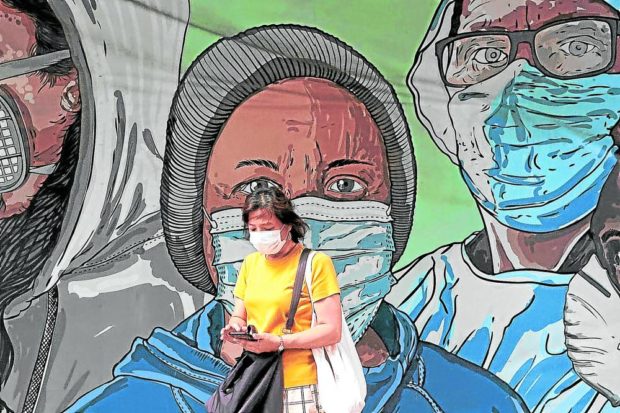
LOW ADMISSIONS A pedestrian tinkers with her mobile device in front of a mural of people wearing face mask in Quezon City. Despite the entry of new variants, hospital admissions have remained low. —FILE PHOTO
MANILA, Philippines — Despite the entry into the country of highly immune-evasive and fast-spreading Omicron subvariants, the COVID-19 situation remains manageable as hospital admissions and severe and critical cases stay low, according to the Department of Health (DOH).
The genome sequencing conducted by the Research Institute for Tropical Medicine and Philippine Genome Center (PGC) from Jan. 30 to Feb. 3 detected the country’s first case of XBB.1.5 and the first three cases of Omicron CH.1.1.
XBB.1.5, known as the “Kraken,” is a descendant of Omicron XBB and currently accounts for more than 60 percent of COVID-19 cases in the United States. It has also been found in nearly 69 countries. Omicron CH.1.1, on the other hand, is derived from BA.2.75 or the “Centaurus.”
In a statement, the DOH said that even with the detection of these COVID variants and subvariants, hospital admissions and severe or critical cases remained manageable.
“The DOH is continuously monitoring these variants and coordinating with WHO (World Health Organization) for more guidance,” it added.
Of the 1,078 COVID-19 positive samples that recently went through genome sequencing, nearly half or 42 percent were identified as Omicron BA.2.3.20, followed by Omicron XBB, including the new XBB.1.5 (18 percent); XBC (7 percent) and BA.5 (2.6 percent).
Only a few samples were identified as other Omicron variants while some had no assigned lineage yet.
PGC executive director Cynthia Saloma earlier cautioned that it was “only a matter of time” before XBB.1.5 made its way to the country.
‘Immune evading’
The European Centre for Disease Prevention and Control (ECDC) has classified it as a variant of interest “due to its increasing prevalence globally and enhanced immune evading properties.”
The US Centers for Disease Control and Prevention estimated that XBB.1.5 accounted for 66 percent of COVID-19 infections as of Feb. 4.
According to the WHO’s Jan. 25 rapid risk assessment, XBB.1.5 has a “moderate” growth advantage.
“Based on its genetic characteristics and growth rate estimates, XBB.1.5 is likely to contribute to increases in case incidence globally. There is moderate-strength evidence for increased risk of transmission and immune escape,” WHO said in its report.
“From reports by several countries, no early signals of increases in severity have been observed. The number of cases associated with XBB.1.5 is still low and thus severity cannot yet be confidently assessed,” it added. The CH.1.1, meanwhile, has been classified by the ECDC as a variant under monitoring “due to its increasing prevalence and potential for immune escape.” It is already in circulation in 71 countries.
While COVID-19 infections in the Philippines have gone down in recent weeks, numbering only 36 on Sunday, DOH officer in charge Maria Rosario Vergeire said the public should be cautious in their interpretation of the figures since most people no longer test themselves or just prefer to use rapid antigen test kits.
As of now, the DOH only includes in its count people found positive using real-time reverse transcription-polymerase chain reaction or RT-PCR tests.